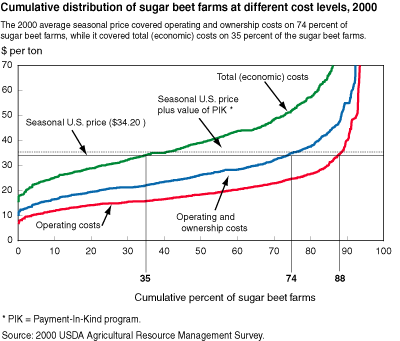U.S. Sugar Beet Farming—How “Sweet” Is It?
- by Mir Ali
- 2/1/2005
All of us with a sweet tooth have a keen appreciation for sugar. But few of us realize that the United States is the world’s fourth-largest producer of sugar (after Brazil, India, and the European Union), or that more than half of U.S. sugar production comes from sugar beets. (Most of the rest comes from sugarcane.) U.S. sugar beet production has grown significantly over the past decade, tied primarily to expanded processing capacity among sugar beet factories. U.S. farmers produced 33 million tons of sugar beets on 1.6 million acres in 2000, versus 28 million tons of sugar beets on 1.4 million acres in 1990. Most sugar beets were processed in 26 factories near production areas to minimize transportation costs and deterioration of sugar content.
U.S. sugar beets are generally grown in areas with cooler climates; the Red River Valley (in western Minnesota and eastern North Dakota) is the largest and fastest-growing sugar beet-producing region, accounting for nearly half of U.S. total beet acreage in 2000. The Pacific Northwest, Great Plains, and Great Lakes regions also have substantial sugar beet production. However, some sugar beets are grown in warmer climates like the Imperial Valley of California.
U.S. sugar beet producers incurred operating costs (inputs, hired labor, etc.) averaging $18.37 per ton of sugar beets in 2000; and total costs (including depreciation in farm machinery, value of land and operator labor) averaged $37.30 per ton. But costs vary widely among farmers due to differences in yields, input use, irrigation, farm size, and location.
At the 2000 average market price of $34.20 per ton of sugar beets, 88 percent of U.S. sugar beet producers were able to cover their operating costs and 35 percent were able to cover their total (economic) costs. In 2000, producers had the opportunity to participate in the payment-in-kind (PIK) diversion program to destroy sugar beets on a specified number of acres in return for a like amount of government-owned sugar. With the 2000 diversion program providing nearly three-quarters of producers an average of $44 worth of sugar per planted acre, 89 percent of producers were able to cover their operating costs and 43 percent were able to cover their total (economic) costs of sugar beet production.


